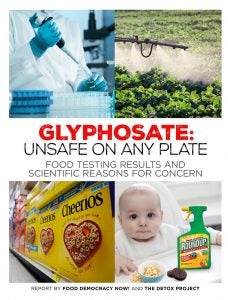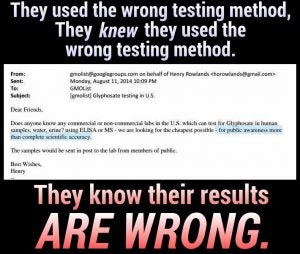Fear is the new sex when it comes to selling something.
You may have heard that the popular weedkiller glyphosate is found in food. This claim has been debunked for years but the rumor has recently reared its ugly head again. Snopes did a good debunking of this, and if you’d like to learn more on the actual science behind why this information is bogus, this podcast does a great job explaining.
In short, the methodology was entirely flawed and never had any solid proof or peer-reviewed evidence behind the claim. In fact, this is what the cover photo of the “report” looks like:

A guy in a scary hazmat suit, “drenching” fields in toxic chemicals, next to your beloved baby about to eat junk food (is that baby old enough to eat Oreos, by the way?) and a horrible Photoshop job of Roundup (glyphosate) on your kid’s dinner tray. Does this look like credible, science-based sourcing to you? Didn’t think so.

If you look at who’s behind this “report,” it comes from places like Food Democracy Now, the Detox Project, the Food Babe, Carey Gillam from US Right to Know, etc. These people have an agenda and get all of their funding from organic food companies, which spend billions of dollars each year leading with fear as an industry to sell their products. They’ve also been involved with creating movies like “Food, Inc.” which don’t speak the truth about modern farming whatsoever. Gary Hirshberg, chairman of Stonyfield Organic and founder of Only Organic and Just Label It, among others, has been an outspoken anti-GMO activist for a very long time but has absolutely no solid evidence for his claims. GMOs are scientifically proven to be just as safe as their non-GMO counterparts and offer numerous benefits to farmers and the environment.
Not only that, but apparently there’s a new food label they’re affiliated with. A “glyphosate free” label, and trying to sell a “glyphosate detection kit” for $125. Follow the money.
The problem — to detect glyphosate that actually gives solid results costs hundreds of thousands of dollars and is a very difficult, scientifically complex task. Sorry, Zen Honeycutt, $125 for a little “test kit” just isn’t gonna cut it. (So make sure you don’t fall for these sales gimmicks, just like her video selling “tiny hydrogen” as a sort of magical elixir of sorts.) Oh boy.
Their own emails have proven that these results are phony as well.

The testing they did to try to tell people glyphosate is in food or whatnot can detect any material that may be similar. Water? Other types of liquid or molecules? And why only test for glyphosate? Why not test for other chemicals like pesticides used in organic farming?
I’m a farmer. That’s it. I’m not trying to sell you something, I don’t get funding from any big corporations, I have no agenda. But what drives me absolutely bonkers about all this stuff is that farmers are real people who really care.
Yes, on our farm we grow field corn. Yes, sometimes we spray glyphosate, or other crop protection products (pesticides). Without these products, up to 80 percent of the world’s food production would be lost. These activist groups want people to be scared of food, and as a farmer I have a problem with that. We family farmers raise our children where we live. These farms are our family history and livelihood. Farmer’s kids play in their cornfields and proudly eat what they grow straight from the field. Why would they grow something harmful and purposely try and hurt themselves and others? (And why am I so healthy?)
The science on this podcast from land-grant professor Dr. Kevin Folta I am listing again here explains the facts pretty solidly. But I can also say with great certainty as a farmer it would be humanly impossible for glyphosate to end up in food and here’s why:
As I’ve previously explained, when we spray our cornfields (one example here) it is at a rate of 22 ounces per acre, which is equivalent to less than two beer cans worth over an area of land the size of a football field. We only spray two days out of an entire year at the beginning of the growing season, long before the edible part is present.
These activist groups such as Food Babe want you to believe glyphosate is found at “alarming levels” in your food. Are you kidding me?
You mean to tell me that that very minuscule amount of spray we use on an acre that produces over 13,000 pounds (nearly SEVEN TONS) of corn, long before the ear is even present, protected by a husk, dried, tested at the USDA facility, and processed into junk food is found at alarming levels in food?
Absolute nonsense, give me a break!
And let’s not forget, this is junk food we are talking about here. How about instead of eating Oreos, which no one ever said were good for you, we eat fresh fruits and veggies instead?
It’s all purely impossible.
Just for fun and for arguments sake let’s say that I’m wrong. Let’s say that what these activist groups are saying is true. They claim it’s in levels at parts per billion. Billion. That’s equivalent to a pinch of salt in ten thousand pounds of potato chips. It’s half a teaspoon in an Olympic sized swimming pool. Glyphosate is a popular weed killer that affects the EPSPS enzyme found in plants — not mammals or insects. With an LD50 value of 5600 mg/kg and available at any Home Depot or Walmart, it’s literally less toxic than baking soda. (I’m sure plenty of people eating this junk food are also washing it down with alcohol …) Let’s never forget basic toxicology, the dose makes the poison.
Again, what happens in the food processing aspect is far worse than what happens on the farm level. If you want to eat Oreos, Cheerios, crackers, or whatever else, go ahead and do so in moderation. They’re delicious and not always good for you, but not because there’s weed killer in it.
Michelle Miller, the Farm Babe, is an Iowa-based farmer, public speaker, and writer, who lives and works with her boyfriend on their farm, which consists of row crops, beef cattle, and sheep. She believes education is key in bridging the gap between farmers and consumers.



